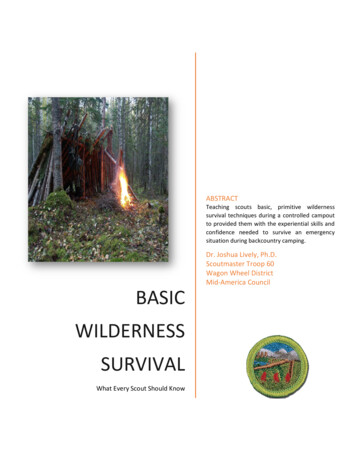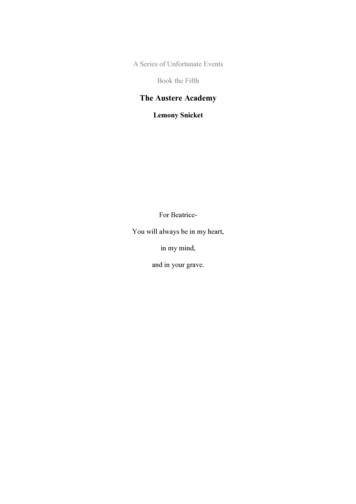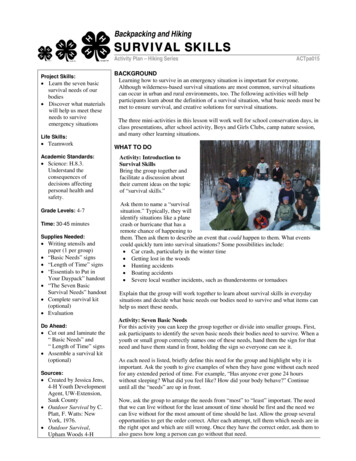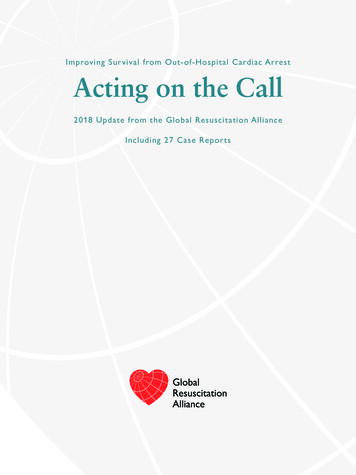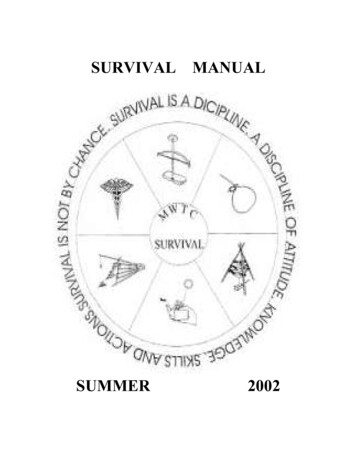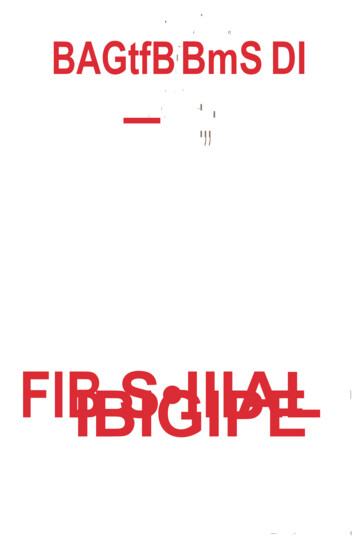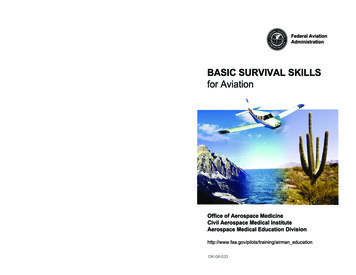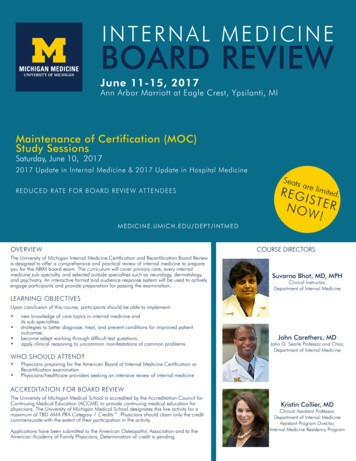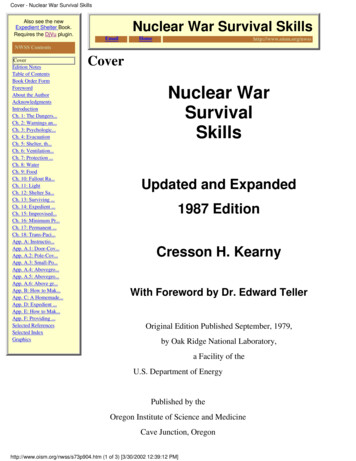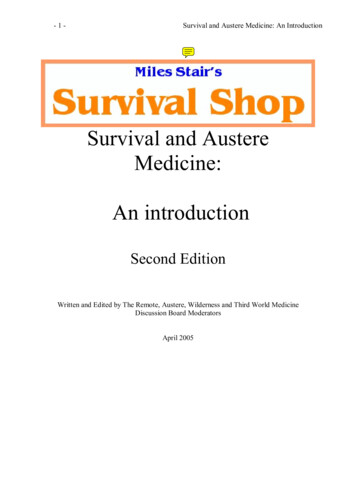
Transcription
-1-Survival and Austere Medicine: An IntroductionSurvival and AustereMedicine:An introductionSecond EditionWritten and Edited by The Remote, Austere, Wilderness and Third World MedicineDiscussion Board ModeratorsApril 2005
-2-Survival and Austere Medicine: An IntroductionCopyright 2005: Excluding contributions attributed to specific individuals, allmaterial is copyrighted to the authors and all rights are reserved. This work may becopied and distributed freely as long as the entire text and all disclaimers andcopyright notices remain intact. This material may not be distributed for financial gainor included in any commercial collections or compilations.Any constructive comments and debate are welcome. We welcome correction in anyerrors of fact. We apologise for any errors of grammar or spelling they are entirelyours. We have tried to avoid detailing specific managements (although we haven’tbeen entirely successful) for various conditions as we do not consider this to be anappropriate forum for that sort of detail and we suggest you consult the references.Contributors and Editors: This book is a combined effort. The primary chapterwriters are credited, but there have been many contributions within chapters fromothers. We have also had editorial assistance and constructive comment from anumber of others whose efforts we greatly appreciate.BCE. MD (BCE)A Grey Man. Lab Tech (GM)Goatlady. Herbalist (GL)Reasonable Rascal. RN/Paramedic (RR)Swedeglocker. Medic (SG)Tangent. EMT (TG)Resqdoc. MD (RQD)
-3-Survival and Austere Medicine: An IntroductionREAD THIS FIRST !Disclaimer: The editors and authors accept no responsibility for the use or misuse ofthis information. The practice of medicine is something that should only beundertaken by trained professionals. If you start administering medical or surgicaltreatments without the appropriate skills you will kill someone. Even in emergencysituations often no action is better than uninformed and untrained action. Anypractice of survival medicine should be backed up with appropriate training.Much of this information is offered to give you perspective of what may be possiblein a long term catastrophic disaster or when working in an austere or remoteenvironment without access to organised or trained medical care – we in no wayendorse practicing these techniques except in such a situation.This information is offered as personal opinions and should not be taken to represent aprofessional opinion or to reflect any views widely held within the medicalcommunity. Appropriate additional references should be consulted to confirm andvalidate the information contained in this book.
-4-Survival and Austere Medicine: An er 1Introduction9Chapter 2What do I need to know & how do I learn it? (BCE) 12Formal trainingInformal trainingChapter 3Organisation (BCE)18Chapter 4Medical kits (BCE)21Obtaining medical suppliesStorage and rotationHow much?Specific medical kitsSurgical instrumentsChapter 5Antibiotics (BCE)39BacteriaAntibioticsChapter 6Sterilisation and disinfection (TG)44Chapter 7The basic laboratory (GM)51Urine testingBlood countsBlood groupingCross matchingGram stainingPregnancy testsGlucose testingChapter 8Herbal and Botanical medicine (GL)Preparation of botanicals and herbs for storageMedicinal botanical preparation methodsSpecific botanicals and herbs65
-5Chapter 9Survival and Austere Medicine: An IntroductionOther alternative medicine (BCE)80General pointsColloidal Silver“The Placebo effect”Chapter 10Medical aspects of shelter living (BCE)83Psychological problemsInfectious diseaseLightExerciseNutritionChapter 11Long-term survival medicine blic healthPatient assessmentTreatment/TherapiesChapter 12Woman’s Health Issues ngChapter 13Medical aspects of NBC warfare (SG)117NuclearBiologicalChemicalChapter 14Wound closure and suturing (BCE)127Chapter 15Austere Dental care (BCE/RQD)131Preventive dentistryScaling and cleaningDrilling and fillingDental traumaExtractionsProsthetics
-6-Survival and Austere Medicine: An IntroductionChapter 16Nursing care in an austere environment (RR)143Chapter 17Frequently asked questions (BCE)169What is Ketamine?How do I debride a wound?Can I give resuscitation fluids rectally?How do I amputate a leg?Can I use Superglue to close a wound?How do I know if someone is dead?Why is diarrhoea important?How likely is an infectious disease like SARS or a new strain ofinfluenza to cause a major disaster?What is influenza? What is “Bird flu”?Will Tamiflu save me from the Pandemic?How do I use maggots to clean a wound?Can I use sugar to treat an infected wound?How do I “set” a broken bone?How do I recognise and treat a heart attack in an austere situation?Do I need Quickclot or Traumadex to control bleeding?What is the most useful antibiotic?What do I do if I’m allergic to penicillin?When should I stop using antibiotics?Chapter 18Reference books (RR)183First tier referencesSecond tier referencesThird tier referencesChapter 19Austere medicine sound bites193Chapter 20Survival Medicine Fiction194AmputationThe apprenticeAppendix 1Equipment suppliers209
-7-Survival and Austere Medicine: An IntroductionBackgroundThis book is a major revision of the Survival Medicine FAQ’s (Frequently AskedQuestions) originally written for the misc. survivalism Usenet newsgroup in 1997. Itwas written in response to recurring posts asking the same questions and the fact thatmany answers were often wrong and occasionally dangerous. It hasn’t undergone anychanges or revisions since then.While the original content remains valid we thought it was time it underwent anupdate. This is a significant revision – most sections have been re-written and anumber of new sections added. We hope you will find it useful. It is offered in goodfaith but the content should be validated and confirmed from other sources beforebeing relied on even in an emergency situation.There are very few books aimed at the “Practicing Medicine after the End of theWorld As We Know It” market – which is hardly surprising! So we hope this bookfills a void. We also hope it will be useful for those people delivering health care inremote or austere environments.It is not designed as a “how to do x” reference – although there is some of that. Thereare plenty of books which tell you how to practice medicine. It is designed to providesome answers to commonly asked questions relating to survival/preparednessmedicine and to provide relevant information not commonly found in traditional textsor direct you to that information.We have tried to minimise technical language, but at times this has not been possible,if you come across unfamiliar terms – please consult a medical dictionary.It has taken two years, and a lot of stopping, and starting but here it is. The authorsand editors are passionately committed to helping people develop their medicalknowledge and skills for major disasters. We hope you find it useful.Web Site:For questions and comments the authors can all be contacted via posting at thefollowing website:“The Remote, Austere, Wilderness and Third world Medicine Forum”http://medtech.syrene.net/forum/
-8-Survival and Austere Medicine: An IntroductionMedicine at the End of the World“With no antibiotics there would be no treatment for bacterial infections; pneumoniaor a simple cut could kill again, contagious diseases (including those sexuallytransmitted) would make a come back, and high mortality rates would be associatedwith any surgery. Poor hygiene and disrupted water supplies would lead to anincrease in diseases such as typhoid and cholera. Without vaccines there would be aprogressive return in infectious diseases such as polio, tetanus, whooping cough,diphtheria, mumps, etc. especially among children. People suffering from chronicillnesses such as asthma, diabetes, or epilepsy would be severely affected with manydying (especially insulin-dependent diabetics). There would be no anaesthetic agentsresulting in return to tortuous surgical procedures with the patient awake or if theywere lucky drunk or stoned. The same would apply to painkillers; a broken leg wouldbe agony, and dying of cancer would be distressing for the patient and their family.Without reliable oral contraceptives or condoms the pregnancy rate would rise andwith it the maternal and neonatal death rates, women would die during pregnancy anddelivery again, and premature babies would die. Women would still seek abortions,and without proper instruments or antibiotics death from septic abortion would becommon again. In the absence of proper dental care teeth would rot, and painfulextractions would have to be performed. What limited medical supplies availablewould have to be recycled, resulting in increasing risks of hepatitis and HIVinfection.”
-9-Survival and Austere Medicine: An IntroductionChapter 1IntroductionWhat is preparedness/survival medicine? Our definition is: "The practice ofmedicine in an environment or situation where standard medical care and facilities areunavailable, often by persons with no formal medical training". This includes medicalcare while trekking in third world countries, deep-water ocean sailing, isolatedtramping and trekking, and following a large natural disaster or other catastrophe.The basic assumption is that trained doctors and hospital care will be unavailable for aprolonged period of time, and that in addition to providing first aid - definitivemedical care and rehabilitation (if required) will need to be provided. Also the basicsof personal and public hygiene will also need to be considered.Austere medicine is the provision of medical care without access to moderninvestigations or technology.As is the case with any aspects of preparedness you need to decide what you arepreparing for and plan accordingly. For some it will only be a 72-hour crisis, forothers it will be a major long-term event, and for yet others a multiple generationscenario. Your medical preparations will need to reflect your own risk assessments interms of what knowledge and skills you develop and whatsupplies/equipment/medicines you store. This book is more slanted towardspreparation for medium to longer term disasters. But most of the included informationis applicable to shorter situations as well.A recent Internet survey asking about medical risk assessments in a major disastercame up with the following results:“What do you see as the most likely common source of medical problems?Battlefield injuriesLack of surgical careEnvironmental relatedInfectious disease (naturally occurring)Infectious disease (biological warfare)Nuclear conflict (radiation, blast, burns)5%36 %8%64 %20 %4% ”(Frugal’s forum 1/04 with permission. http://www.frugalsquirrels.com)What you may have to deal with will depend on what happens. Obviously a nuclearwar will produce a different set of problems than a pandemic. However, regardless ofwhatever the initial triggering event after the initial wave of injuries or illnessassociated with it the majority of medical problems that happen will be common, andmundane, and not nearly as interesting as the above survey results suggests.
- 10 -Survival and Austere Medicine: An IntroductionBelow are the results of one author’s experience in the provision of health care invarious remote and austere locations (some third world, some first world) to nearlytwo thousand people over a cumulative 15-month period (spread over 10 years). Therecord keeping was a bit unreliable at times, but the following summary is reasonablyaccurate.The Top 20 presentations:1. Minor musculoskeletal injuries (ankle sprains most common)2. Upper respiratory tract infections3. Allergic reactions/Hay fever/Anaphylactic reactions/Rashes4. Minor open wounds5. Gastroenteritis/Vomiting/Diarrhoea6. Sexual health/Contraceptive problems7. Skin infections/Cellulitis8. Mental health problems9. Dental problems10. Abdominal pain (2 confirmed acute appendix 1 gangrenous gallbladder; no cause found. Renal or biliary colic were most common)11. Flu/Viral illness12. Chest infections13. Major musculoskeletal injuries (fractures/dislocations)14. Asthma15. Ear infections16. Urinary tract infections17. Chest pain18. Syncope/Collapse/Faints19. Early pregnancy problems20. BurnsTop 12 prescribed drugs:1.2.3.4.5.6.7.8.9.10.11.12.Paracetamol (Acetaminophen)Loratadine (and other assorted antihistamines)Diclofenac (and other assorted antiinflammatories)Combined oral contraceptiveFlucloxacillinThroat lozengesAugmentinLoperamideNystatin (and other antifungals)Hydrocortisone creamVentolin inhalersMorphineThe above gives you a variety of insights into what medical problems might occur andwhat medications are likely to be required. Most of it relatively mundane and not lifethreatening. Truly catastrophic problems in medicine are fortunately rare. You should
- 11 -Survival and Austere Medicine: An Introductionfocus on dealing with the common problems, and doing common procedures well, andyou will save lives, and improve the quality of people’s lives. While major trauma andsurgical emergencies occur – they are reassuringly not that common. To deal withthese will require additional knowledge and resources over and above what is requireto safely manage 95% of common medical problems.Perhaps the single most important piece of advice inthis book:While the focus of this book is on practicing medicine in an austere environment itdoes not address one key area which must be considered as part of your preparations:That is optimising your health prior to any disaster; losing weight, keeping fit,maintaining a healthy diet, and managing any chronic health problem aggressively.This is well covered in 100s of books about getting fit and staying healthy, but if youdo not take some action in this regard all of your other preparations may be in vainwhen you drop dead of a heart attack from the stress of it all.
- 12 -Survival and Austere Medicine: An IntroductionChapter 2: What do I need to know and how doI learn it?The more you learn the better! Start off learning basic first aid. Then try and learn asmuch anatomy and physiology as possible –A & P are the building blocks ofmedicine. Once you understand how the body is put together and how it works youare in a much better position to understand disease and injury and apply appropriatetreatments. Then you should try and obtain some more advanced medical educationand practical experience.There is no syllabus that we can list that will tell you what you need to know to coverevery eventuality. Table 2.1 contains some core basic knowledge skills, which shouldbe considered fundamental to anyone assuming responsibility for providing medicalcare.While having a list of core knowledge is helpful. Ultimately what you need to be ableto do is: “Know how to perform a basic assessment, established a rough workingdiagnosis, and know where to look to find further information about what to do next.”The fact you don’t know all the fine print doesn’t matter, the key is having a roughidea of what is going on, and knowing where to look to find out more, and ensuringyou have the references available.Medicine is dangerous, and uninformed decisions and actions will kill people. Despitehaving said that a lot of medicine is simply common sense. Anyone with a bit ofintelligence, a good A&P book, and a good basic medical text can easily learn thebasics. The ideal is a trained health care professional and anything else is taking risks,but in a survival situation any informed medical care is better than no medical care.Please note we say informed; if you really don't have a clue what you are doing youwill be very dangerous.Formal trainingProfessional medical training: The ideal option is undertaking college study in amedical area e.g. Medicine, Nursing, Physicians Assistant, Paramedic, Vet, etc. Thisclearly isn’t an option for many, but it is still the best option and should be clearlyidentified as such.Other Formal training options by region:N.B In the following sections a number of commercial courses are mentioned. Wehave no financial interest in any of these courses. While we have heard positive thingsabout the commercial courses mentioned we do not offer any endorsement of any
- 13 -Survival and Austere Medicine: An IntroductionTable 2.1 Core knowledge and skills to aim forUse a good medical dictionary and a basic medical textbook to answerquestions – know where to look to find answers to things you don’t know.Perform basic bandaging and dressings. Clean a wound, debride a burn.Use local anaesthetic to numb a wound.Debride and suture a wound, but also know when not to suture a wound, andleave it open or perform delayed closure.Deliver a baby and afterbirth. Suture a vaginal tear, manage a post-partumbleed.Reduce and immobilise a short and long bone fracture/dislocation.Use basic counselling skills.Understand basic hygiene and preventive medicine practices.Recognise and treat common infections:- Viral flu- Upper respiratory tract infections- Pneumonia- Urinary infection- Wound or skin infection- Common STD'sRecognise and treat common medical and surgical problems:- Asthma/respiratory distress- Abdominal pain – renal (kidney) stones/appendix/biliary stones- Allergic reactions/anaphylaxisLook after some one who is bed bound, e.g. basic nursing care, managing theunconscious patient, catheterisation.Use basic dental skills, simple fillings, infections, and extractions.Insert an IV and understand basic fluid resuscitation.Improvise medical equipment and supplies.
- 14 -Survival and Austere Medicine: An Introductionparticular course or any warrantee as to the quality of the teaching provided. Timeschange and good things can and do go bad. When looking at a particular course lookin detail at what is being covered (e.g. is it a national standard? Does it cover whatyou need to know?) And who are the instructors? (Do they have credibility? What aretheir backgrounds?)United States:EMT Basic: This is the national standard for providing Emergency care in the USA.The courses follow a curriculum set out by the US Dept of Transportation. They areoffered by many community colleges. While in theory the content is the same, there iswide variation in quality of teaching over different sites. The best feedback you arelikely to get will come from previous students. The course length is usually severalhundred hours.This is probably the minimum standard to aim for – it provides an overview ofanatomy and physiology, and an introduction to the basics of looking after sick andinjured patients. It is based around delivering the patient to a hospital as an end resultso is of limited value in remote and austere medicine – but it provides a solidintroduction.Additionally, the US recognizes various levels of EMT which we will generically callIntermediate and Paramedic;EMT-Intermediates are generally allowed to initiate venous access and to administer amodest array of emergency drugs, use oesophageal and blind intubation airwaydevices such as the Combitube, and use automated defibrillators. Patient assessmentskills are also more developed than with the EMT-B or First Responder. Overalltraining is approximately 400 hours in addition to the pre-requisite EMT-Basiccourse.EMT-Paramedics constitute the highest level of training for most states. In addition toall previous skills accorded EMT-Bs and Is they may make use of a significantlylarger array of medications including gaseous analgesia, paralytics and amnesics.They may also perform airway intubation via direct visualization, perform 12-leadinterpretive EKGs, and in some jurisdictions are trained as community healthproviders able to perform immunizations, reduce minor dislocations, and performsimple wound closure.First Responder: If you are unable to undertake an EMT-B course, this provides the“lite” version. Covering similar material in much less detail it is a good start but notoverly in-depth. The usual course length is 40-80 hours – most quality schools offer a60 hour course. Various community education groups offer the course and the RedCross also offers a variation.
- 15 -Survival and Austere Medicine: An IntroductionThe next level down from first responder is a standard “First Aid” course offered bythe Red Cross and many other organisationsEMT/Wilderness EMT Course: For most this is a much more realistic option thanformal college training. These courses give a basic background in anatomy andphysiology, medical terminology, and the essentials of emergency medicine. Itprovides the basis for additional self-directed learning. Most community collegesoffer these courses. The basics are well covered in the "first responder"/First Aidcourses, which although very elementary provide a good stepping stone to the moreadvanced courses while not requiring the same time commitments as a full EMTcourses.Tactical EMS: There are a number of courses available which focus on tactical EMS– the provision of emergency care in hostile environment and for prolonged periods.Frequently they have a prerequisite of at least EMT-B and usually some practicalexperience in a tactical environment. However some provide more entry-levelcourses. The focus of these courses is primarily on trauma and combat associatedinjuries. The quality of these courses varies enormously.The original tactical EMT programme was developed by the US Protective Services,Counter Narcotics, and Terrorism program (CONTOM). They offer both basic andadvanced EMT-Tactical programmes. Typically they are accessed through lawenforcement programmes.Another highly recommended course is the Operational and Emergency MedicalSkills course. (http://www.oems.org/index.html). This course is unfortunately onlyavailable to medical staff attached to the Department of Defence and other federalagencies. FEMA staff and those involved in their Emergency Response teams haveattended.Some other providers of these types of courses include:Insight training http://www.insightstraining.comHK Tactical Medical Training http://www.tacticalmedicine.com/Global Medical rescue Services: GMRS offer a variety of excellent courses in remoteand tactical medicine. Occasional courses focused on preparedness type medicine arealso offered. These courses are unique in catering specifically for survival situationsand are highly endorsed. http://www.gmrsltd.com/(Editors note: Potential conflict of interest. One of the Editors is involved at an instructor level andothers have taken courses with GMRS Ltd.)
- 16 -Survival and Austere Medicine: An IntroductionCanadaSt. John Ambulance: SJA provides the bulk of private first response and basic EMTtraining in Canada. There are probably a number of other more advanced coursesavailable but we have had difficulty obtaining information on them.United Kingdom:First aid certificate: Basic first aid course. This is usually 8-24 hours worth ofinstruction. This an excellent place to start for those with minimal experience. It isoffered through St. John Ambulance, or the Red Cross, and a number of commercialproviders. If you are a member of either organisation they provide much morecomprehensive training up to EMT basic level.BASICS: The British Association for Immediate Care Schemes runs several courseswith provide extensions from basic first aid. While not specifically focused onpreparedness medicine, they provide an opportunity for non-professionals to obtainteaching up to an EMT-P theory level – although lack the practical hours. They offerthe basic Immediate Care course and the more advanced Pre-hospital Emergency Carecourse. Both are expensive. They are also affiliated with the Faculty of Pre-Hospitalof the Royal College of Surgeons of Edinburgh.Basic surgical skills for remote medics: An intensive three-day course aimed atteaching the basics of surgical practise and to challenge the students with differentproblems using their newfound skills. Run by Remote Support Medics(http://www.remotemedics.co.uk) in association with The Royal College of Surgeonsof Edinburgh.Diploma in Remote and Offshore Medicine: Currently in development. Should beavailable in 2005. Aimed at medics working in the oil/gas industry at remote sites.This will become the gold standard for non-professional people in the UK gettingexperience for remote or austere medical work. (http://www.remotemedics.co.uk)EMT / Advanced EMT: A number of different courses offered by Advanced LifeSupport Europe (http://www.advanced-lifesupport.com/). Their main gem is a 5-dayclinical course in a UK hospital learning airway and IV skills which is available tonon-professionals provided you have completed one of there pre-requisite courses.Their courses are unfortunately fairly expensive, but potentially very useful.Expedition Medicine: This is one of several courses available in the UK focused onproviding care in remote environments. It appears to be the only course available tonon-doctors and nurses. alia / New Zealand:First aid certificate: Similar situation to the UK. Run by St. John, Red Cross, andsome private providers.
- 17 -Survival and Austere Medicine: An IntroductionWilderness first responder: This a 10-day course offered by the Wilderness MedicineInstitute at various sites around Australia. Not delivered at a particularly advancedlevel, but goes well beyond a standard first aid course and is focused on remote work.(http://www.wmi.net.au)Informal TrainingEmergency Department Observing: It is possible to gain some experience observingor working in an ER. Many Emergency Departments regularly have a variety ofpeople coming through for practical experience from army medics, to off-shore,island, forest service staff, to fishing boat medics. If you can provide a good reasonfor wanting to gain skills in the emergency room such as "sailing your boat to theSouth Pacific," then the potential to gain practical experience in suturing, insertingIV's, and burn management is there. In North America this is more difficult toarrange due to insurance issues. However, if you are not actually going to touch apatient and are just going to be there to observe then if you ask the right people itshould be easy to arrange. While not the same as “hands on” experience, simplyexperiencing the sights and sounds of illness and injury will help prepare you for ifyou have to do it yourself.Arrange some teaching: Another option is befriending (or recruiting) a health careprofessional and arranging classes through them. It is common for doctors to beasked to talk to various groups on different topics so an invitation to talk to a"tramping club" about pain relief or treating a fracture in the bush would not be seenas unusual.Volunteering: Many ambulances and fire services have volunteer sections or arecompletely run by volunteers. Through these services you may be able to obtainformal EMT training and at the same time gain valuable practical skills andexperience, overcome fear of dealing with acutely sick people and also work withsome great people. Organisations such as the Red Cross, Search and Rescue units, orSki patrols also offer basic first aid training, as well as training in disaster relief andoutdoor skills. It is also often possible to arrange "ride alongs" with ambulance andparamedic units as the 3rd person on the crew and observe patient care even if you arenot able to be involved.
- 18 -Chapter 3Survival and Austere Medicine: An IntroductionOrganisational issuesIf you are alone or just a couple then organising your medical care is relativelystraightforward. However, the larger the group the more formalised and structuredyour medical care should be. Someone within the group ideally with a medicalbackground should be appointed medic. Their role is to build up their skill andknowledge base to be able to provide medical care to the group. There should also bea certain amount of cross training to ensure that if the medic is the sick or injured onethere is someone else with some advanced knowledge. The medic should also beresponsible for the development and rotation of the medical stores, and for issuesrelating to sanitation and hygiene. In regard to medical matters and hygiene theirdecisions should be absolute, and their advice should only be ignored in the face of astrong tactical imperative.How you deliver care will depend on the size of the group you are looking after.Small groups don’t require a formal “sick-call” or clinic time; you provide care if andwhen required and fit it in around other jobs. For a larger group dedicated time isrequired for running clinics and other related medical tasks e.g. public health workand it may be a full time activity.Risk Assessment/Needs Assessment:As alluded to in the introduction what you plan for depends on what you are worriedabout. As part of your medical preparations you should undertake a detailed needsassessment. You should ask and answer the following questions (at least):1. What am I preparing for?Natural disasters; Nuclear war; Ice ages; Economic collapse; Peak oil, etc.2. How many people will I be looking after?3. What age range will I be looking after?4. How long will we need to be independent for?5. What are their pre-existing health problems?6. What physical condition are they in?7. What physical environment will I be living in?Hot/Cold; Wet/Dry; Underground shelter/above ground, etc.8. What level of medical care can I provide?9. What additional training do I need? How do I get it?10. What supplies do I need? How much of each?11. Do I have sufficient reference books?12. Have I considered how I will deal with difficult issues relating to practicingmedicine: Confidentiality, death and dying, sexuality, scarcity of resources,etc.
- 19 -Survival and Austere Medicine: An IntroductionDocumenta
medical care and rehabilitation (if required) will need to be provided. Also the basics of personal and public hygiene will also need to be considered. Austere medicine is the provision of medical care without access to modern investigations or technology. As is the case with an
